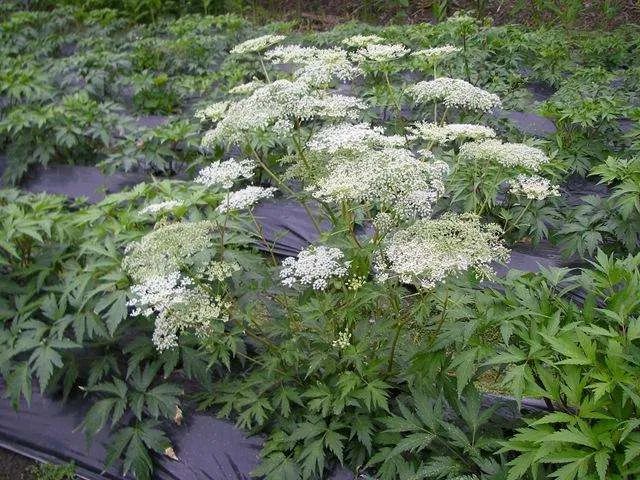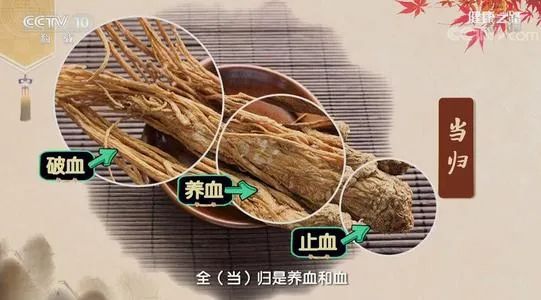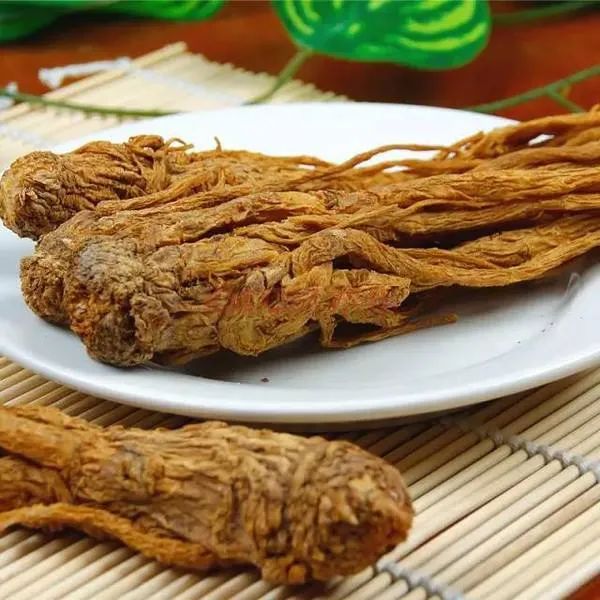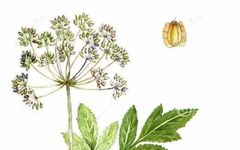Angelica sinensis (当归), also known as Dong Quai, is a perennial herb that grows to a height of 0.4-1 meter. It flowers from June to July and bears fruit from July to September.

Characteristics: This perennial herb has a cylindrical root that branches out with numerous fleshy fibrous roots, which are yellow-brown and have a strong aroma. The stem is erect, greenish-white or purplish, with longitudinal grooves and is smooth without hairs. The leaves are tripinnate, with leaf stalks measuring 3-11 cm long, and the base expands into a tubular membranous sheath that is purple or green. The basal leaves and lower stem leaves are ovate, measuring 8-18 cm long and 15-20 cm wide. The leaflets are in pairs, with the lower pair having petioles 0.5-1.5 cm long, while the upper pair is sessile. The terminal lobes are ovate or ovate-lanceolate, measuring 1-2 cm long and 5-15 mm wide, with 2-3 shallow lobes and serrated edges. The undersides of the leaves and edges are sparsely covered with white, papillary hairs. The upper leaves are simplified into sheath-like structures and pinnately divided leaflets.
The flowers are arranged in compound umbel inflorescences, with peduncles measuring 4-7 cm long, densely covered with fine hairs; there are 9-30 rays. The involucre has 2 linear bracts, or none; the small umbel has 13-36 flowers, with 2-4 linear bracts. The flowers are white, with pedicels densely covered with fine hairs; the calyx has 5 ovate lobes; the petals are oblong with a pointed tip that folds inward; the style is short with a conical base. The fruit is oval to ovate, measuring 4-6 mm long and 3-4 mm wide, with a dorsal ridge that is raised, and lateral ridges forming broad, thin wings that are equal to or slightly wider than the fruit body, with pale purple edges. The fruiting period is from July to September.

Growth Habits: This plant prefers low-temperature, long-day conditions and thrives in cool, high-altitude climates, typically at elevations of 1500-3000 meters. In lower altitude areas, it has a high bolting rate and is not easy to survive the summer. During the seedling stage, it prefers shade with a light transmittance of 10% and should be protected from direct sunlight; mature plants can tolerate strong light. It grows best in deep, loose, well-drained, fertile sandy loam rich in humus and should not be planted in low-lying, waterlogged, or easily compacted clay or barren sandy soils. Continuous cropping is not recommended.

Geographical Distribution: In China, it is primarily produced in the southeastern part of Gansu, particularly in Min County, which has high yield and quality. Other provinces include Yunnan, Sichuan, Shaanxi, and Hubei, where it is also cultivated. Some regions have introduced and cultivated it. The type specimen was collected from Wushan, Sichuan.

Internationally, it is native to Western Asia and is cultivated in various countries in Europe and North America. The main variety, Dong Quai, comes from the Apiaceae family and is also known as Japanese Angelica or Yanbian Angelica. In some regions of Northeast China, it is used medicinally, and the local Korean population in Jilin believes its effects are similar to those of Angelica sinensis. Dong Quai is used medicinally in Japan and Korea as well. Its roots are shorter than those of Angelica sinensis, with a yellow-brown or brown surface, and have fine longitudinal wrinkles and transverse scar-like markings. The main root is short with fine ring patterns, measuring 1.5-3 cm in diameter, with leaf stalk and stem base scars at the top, and a central depression with numerous lateral roots.
Other varieties include European Angelica, which was introduced from Bulgaria in 1957 and differs in characteristics and pharmacological effects from Angelica sinensis, possessing adverse reactions not found in Angelica sinensis. Wild Angelica from Yunnan, known as Tu Dong Quai, has similar effects and is used medicinally in some areas of Yunnan. Its roots are conical with few branches, brown, reddish-brown, or black-brown in color, with stem scars at the top and transverse ring patterns.
Reproductive Methods: Propagation can be done by seeds, either by direct sowing or transplanting seedlings. For seed propagation, when germination is good (over 70% germination rate), the recommended sowing amount is about 7.5 kg per mu. Seeds should be soaked for 24 hours before sowing (at 30 degrees Celsius). There are two methods: row sowing and broadcasting. Broadcasting involves evenly scattering seeds over a leveled bed and covering them with about 0.5 cm of fine soil. Row sowing involves making furrows 20 cm apart, 3-5 cm deep, and evenly sowing seeds in the furrows, covering them with fine soil until the seeds are not visible. Direct sowing can be categorized into spring, autumn, and winter sowing based on the sowing time.
Main Value: Medicinal Value: The root of Angelica sinensis is the primary medicinal part. It is harvested in late autumn, with fibrous roots and soil removed, and dried slowly over smoke after slight evaporation of moisture. The whole root is slightly cylindrical, with the upper part called “Gui Tou” (归头), the main root called “Gui Shen” (归身) or “Cun Shen” (寸身), and the lateral roots called “Gui Wei” (归尾) or “Gui Leg” (归腿). The whole root can both nourish and invigorate the blood, collectively referred to as “He Xue” (和血); the main root nourishes the blood, while the lateral roots invigorate the blood. Processing involves removing impurities, washing, moistening, and slicing before drying. For wine-prepared Angelica, slices are sprayed with yellow wine, slightly moistened, stir-fried over low heat, and cooled (10 kg of yellow wine for every 100 kg of Angelica slices). According to the “Lei Gong Pao Zhi Lun”, when using Angelica, remove dust and hard tips, and soak in wine overnight.
Functions and Indications: Nourishes blood; invigorates blood; regulates menstruation and alleviates pain; moistens dryness and promotes bowel movements. It is indicated for blood deficiency symptoms; irregular menstruation; amenorrhea; dysmenorrhea; masses and accumulations; metrorrhagia; cold abdominal pain; atrophy; numbness of the skin; dry intestines and constipation; post-dysentery heaviness; carbuncles and sores; trauma from falls.
Dosage: For internal use: decoction, 6-12 g; or in pills, powders; or soaked in wine; or applied as a plaster.

Recognizing and Identifying Plants is a public account created by a nature enthusiast who enjoys researching and discussing the natural world. It aims to introduce knowledge about the plant kingdom and invites enthusiasts to learn and discuss together, providing valuable suggestions. Contributions of plant photos are also welcome. Everyone is encouraged to share this with friends and family for collective learning!

Some of the information is compiled from online sources and books.

